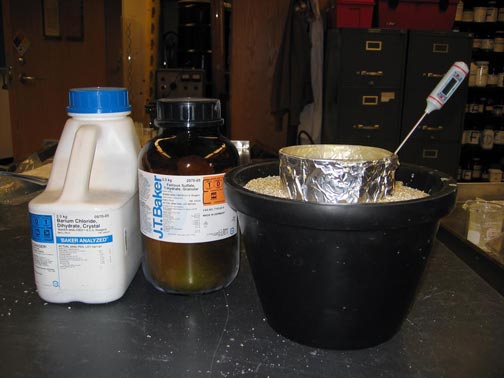Calorimetry of a precipitation reaction
 Solutions of soluble salts are combined to form a precipitate and heat.
Solutions of soluble salts are combined to form a precipitate and heat.
Ingredients: barium nitrate, iron(II) sulfate, insulating container, thermometer
Procedure: A partial recipe follows.
1. Measure the temperatures of the two solutions.
2. Add solutions of barium nitrate and ferrous sulfate to insulating container and stir.
2. Measure the temperature of the solution.
3. Observe the formation of a milky white precipitate.
4. From the change in temperature, compute the heat of reaction.
Understanding: We have found that at constant volume there is no pressure-volume work done and the heat added to the system is equal to the change in energy of the system.
qV = Δ E
At constant pressure the heat added to the system is equal to the change in enthalpy of the systemqP = Δ H
where the enthalpy is defined H=E+PV.When run at constant volume, reactions that lead to an increase in the number of moles of gas can lead to large changes in pressure. And explosions!
It is much easier and safer to run reactions at constant pressure, particularly those that evolve gases. Therefore, when we refer to heats of reaction we typically imply that it is the heat added to the reaction system at constant pressure. That is, the heat of reaction is the change in enthalpy.
The barium nitrate and ferrous sulfate salts are soluble in water at room temperature. The mixture of barium nitrate with ferrous sulfate leads to the precipitation reaction
Ba(NO3)2(aq) + FeSO4(aq) → BaSO4(s) + Fe(NO3)2(aq)
where the net ionic equation for the reaction isBa2+(aq) + SO42-(aq) → BaSO4(s)
The heat of reaction is slightly exothermic -26.29 kJ. That means that 26.29 kJ of heat will be added to the surroundings when one mole of barium nitrate reacts with one mole of ferrous sulfate in one liter of solution.
Careful accounting of heats of reaction
Question: What is the change in temperature of the solution when one liter of a one molar solution of barium nitrate is mixed with one liter of a one molar solution of ferrous sulfate? Assume that the heat added to the surroundings is absorbed by the aqueous solution, which has a specific heat of 4.18 J/g C.You can check your answers here.